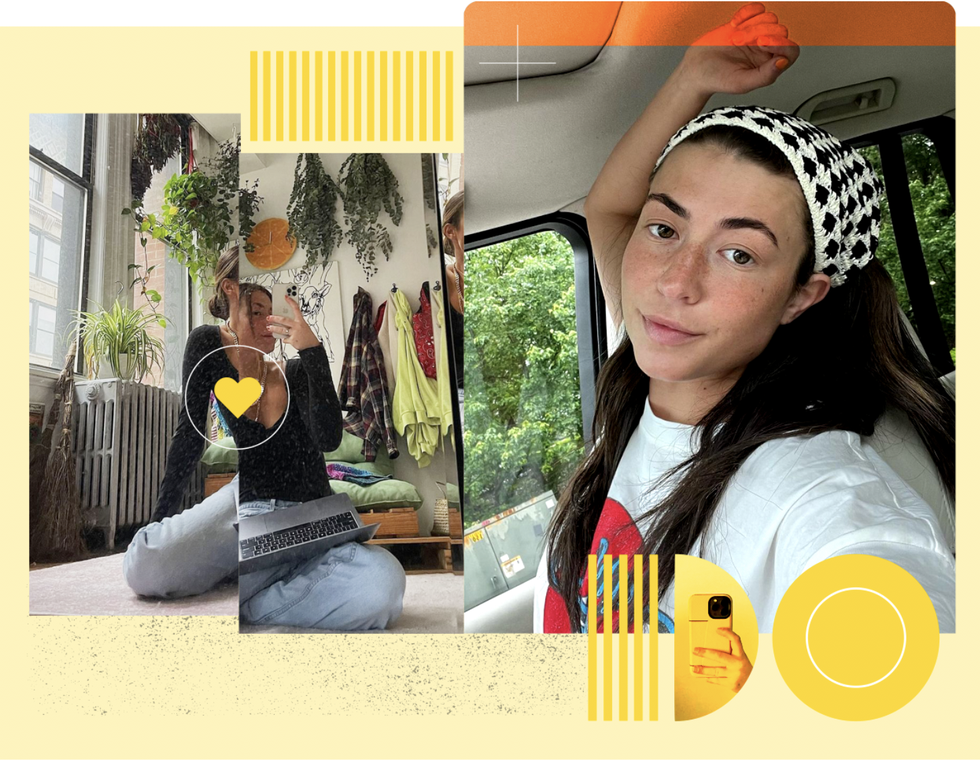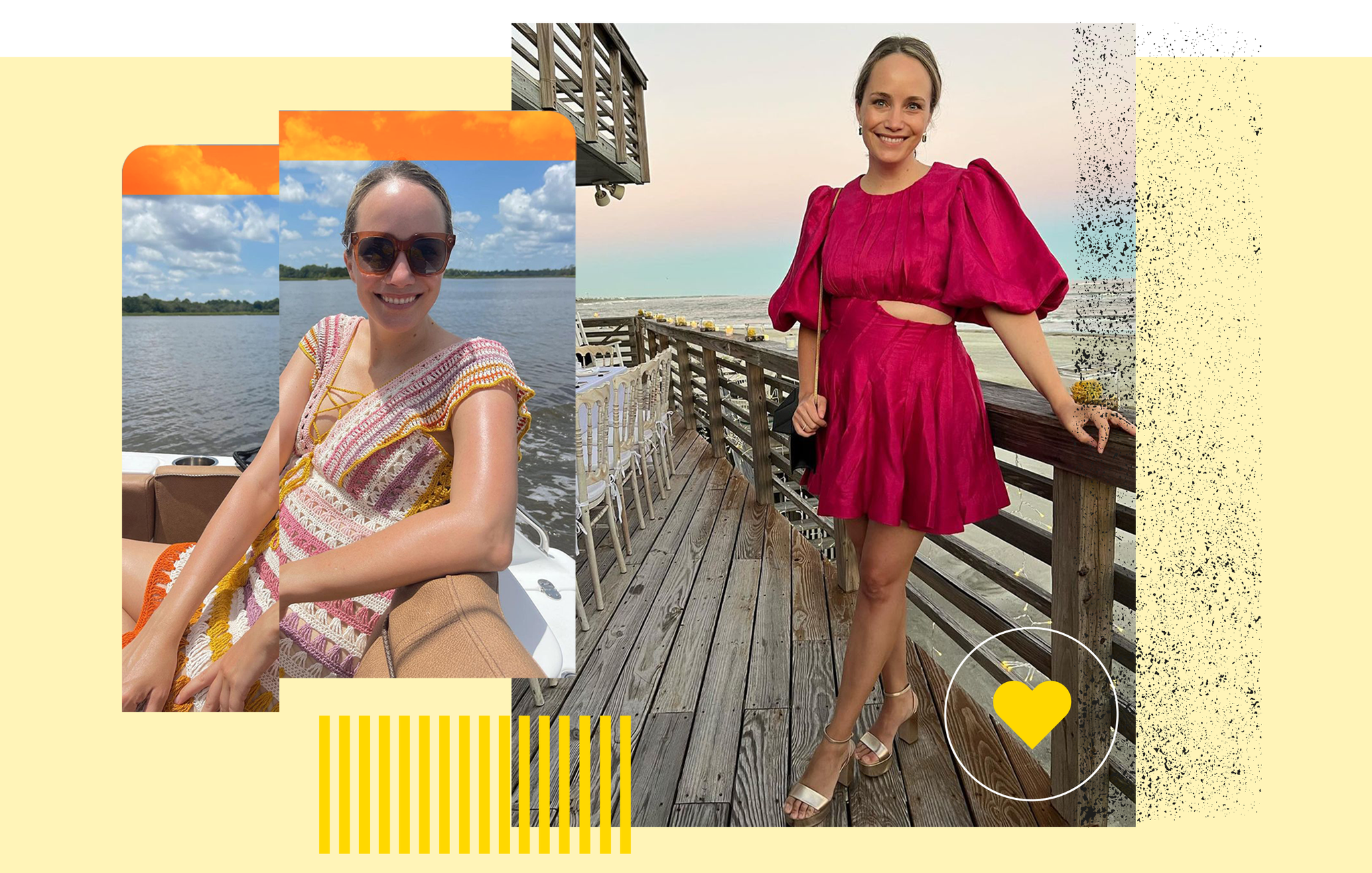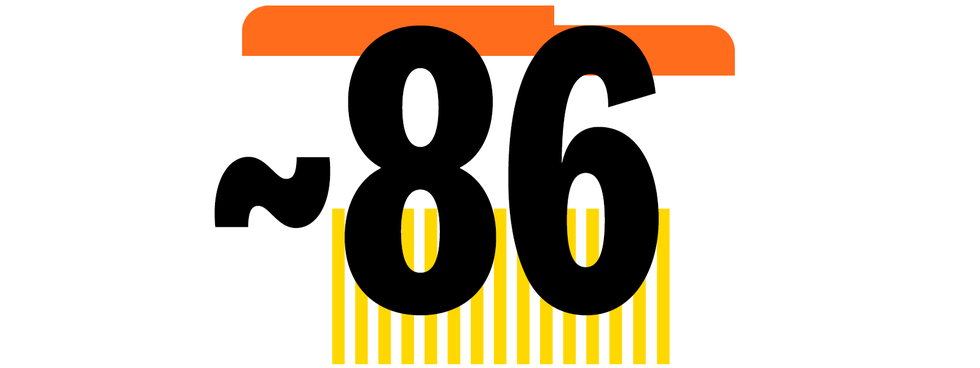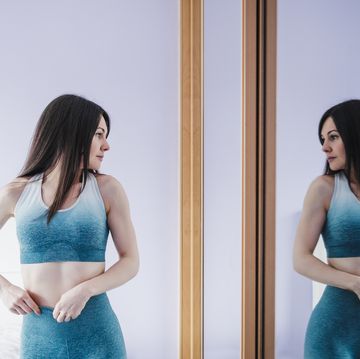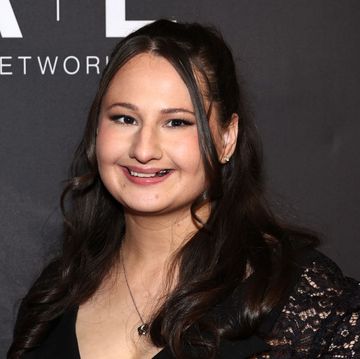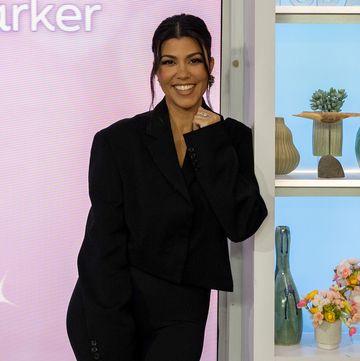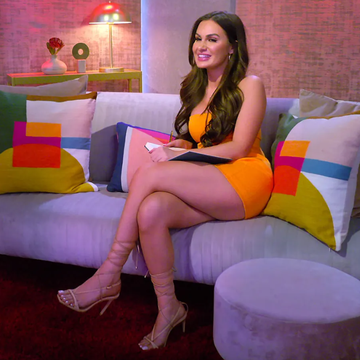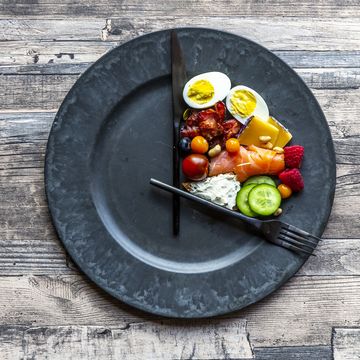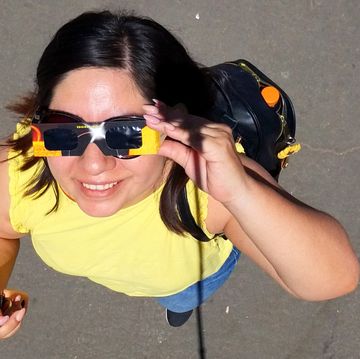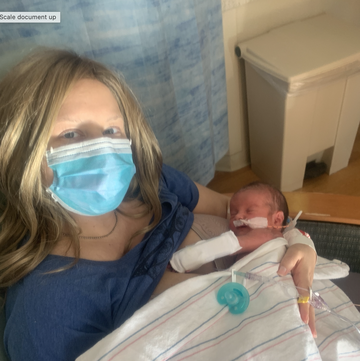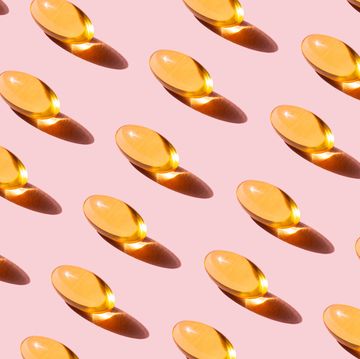Victoria Paris, 23, an influencer and TikTok It Girl with a total follower count approaching 2 million, was known for her “fit pics” with classic New York City backdrops, like colorfully graffitied storefront shutters, food trucks, fire escapes flanked by skyscrapers, bodega aisles lined with rainbow potato chip bags, and her eclectic Manhattan loft, where even her radiator was adorned with Instagram-friendly plant life.
New York was Paris’s aesthetic. Her aesthetic made her money. She left anyway.
For Paris, the benefits she gained from documenting her lifestyle online (from her signature #HotGirlsSweat workout routine to cosmetic procedures like lip tattooing and liposuction on her chin) came with serious consequences too. During her rise to New-York fame, she faced repeated personal space violations and stalking, leading to intense anxiety and paranoia. The dreamy life she shared (and sold) wasn’t as idyllic as it seemed.
“I would hear somebody scream my name multiple times at the top of their lungs, and then they’d run across traffic and physically grab me,” she says. Now, “I hear somebody say my name and I flinch.” One of Paris’s worst encounters was when a group of girls stood outside her apartment building, blocking the entrance and screaming her name as she tried to pass by. She realized—for the sake of her mental health and creative spirit—that she couldn’t stay in the city and moved to a less populated area of Los Angeles County.
“I just want privacy for the first time in years,” Paris says. “I have really bad paranoia, which I have struggled with my whole life, that has exploded under influencing. My brain just doesn’t operate anymore. It operates with the fear of the future.” She hopes proximity to nature and a more relaxed California lifestyle will help her heal.
Still, a cross-country move won’t protect Paris from nasty comments on her posts, Reddit threads dedicated to picking her apart, trauma-dumping from followers in her DMs, and the potential for privacy issues in the future. “The Internet is so emotionally volatile that,” after being dragged through the extreme highs and lows on a daily basis, “I wake up feeling zero,” she says.
And while Paris is certainly a well-known presence on social media, she isn’t alone in feeling anxious, unsafe, or even ambivalent about her influence—which is what leads some to leave the online-content-creation space altogether, even if temporarily.
Take Christian Vierling, 25, who knew he had to go offline when he couldn’t make a TikTok without drinking first. Vierling, a comedy content creator, garnered an audience of more than 1 million followers on TikTok over the past two years—and his videos largely centered on snarky, drunken antics that made viewers laugh during a time of deep cultural sadness. (Read: the pandemic.)
While Vierling, with his charming model-esque looks and infectious personality, was bringing joy and laughter to those around him through his digital hijinks—like filming himself getting hammered alone at a Korean barbecue restaurant or chugging draft beers at the airport—it turns out he was struggling.
“Alcohol problems were a part of my brand for a long time,” Vierling says. “I noticed that having drinks in my videos made me more relatable,” he says, or that when he was drunk, he could push himself to say something “a little crazier” than when he wasn’t. His online persona was that of this “carefree, goofy guy with a little bit of a drinking problem,” Vierling says. Followers ate it up.
“It was fun making the videos with alcohol—until it wasn’t,” Vierling says. “When I’m drinking, I’m not a happy person. I was angry that I couldn’t get myself out of that drinking stage, couldn’t take myself away from it. The only coping mechanism I had was to drink more.” But it makes sense that he was struggling to stop. Whereas most people’s job performance might suffer because of over-drinking, Vierling’s visible alcoholism was driving his success.
The fact that unhealthy behaviors can boost metrics is a common issue when it comes to influencing. For Grace Atwood, 41, who has been working in the influencing space for 13 years, it’s being unable to step away from work. “We can’t take breaks” or our numbers drop, Atwood says, explaining that when she stops posting for the weekend she’ll notice a 30 to 40 percent decline in Instagram story views. (A representative for Meta responded to this claim by pointing out their Recommendation Guidelines and their Creators’ Guide as ways to help influencers learn more about how the algorithm works.) Any drop in engagement is a big problem when you make the bulk of your income from your social media account. For influencers, taking the weekend off from work often means returning to do the same job on Monday for lower pay.
Despite being a veteran in the industry, Atwood says she hasn’t been able to separate her mood from the highs and lows of her account’s performance. “Instagram really messes with my mental health,” she says.
We know that too much time on social media depletes mental health. Yet influencing, as a career or side gig, still has a halo around it.
“The work of being an influencer is extremely fraught,” says Emily Hund, PhD, a researcher at the Center on Digital Culture and Society at the University of Pennsylvania Annenberg School for Communication. Hund studies influencer culture and has interviewed many people in the business. “Everyone I’ve spoken with has reported some kind of mental toll,” she says. And while job stress certainly isn’t unique, the kind that influencers face is particularly vitriolic (violent threats and verbal cruelty from followers) and targets their personal identity.
“People in your comments will talk about you like they’re not in your house. They’ll be like, ‘Who is this bitch? She sucks and thinks she’s so funny.’ When I see that on my phone I start spiraling because I’m like, that’s really who I am, that’s really me,” says Estefania Pessoa, 31, an influencer better known by her username, Tefi, on various social media platforms.
Tefi has amassed over 1 million followers on her many accounts thanks to her pop-culture hot takes. But even as someone in the business of sharing her opinion online, Tefi reached the point where she’d just about had enough—the social media feedback loop was making her depression much worse. She needed a break, and she’s taken one indefinitely, handing her channels off to her team so she can continue posting while also not being active on the Internet herself. “I feel guilty about it,” she says, even after the near-constant influx of hate comments which led to her programming pause in the first place. “I’ve heard about people getting to this point before, and I’ve been like, ‘Oh, that’s so dramatic.’ And then that was me. No money in the world is worth me looking in the mirror and thinking, You’re so terrible,” she says.
Percentage of Gen Z and Millennials who say they would post sponsored content for money
Source: Morning Consult
Despite these pitfalls, being an influencer is still a highly sought-after job. Around 86 percent of Gen Z and Millennials say they would post sponsored content for money, and 54 percent would become an influencer if given the opportunity, according to a report from research firm Morning Consult. For many, creating content feels like an appealing way to achieve financial freedom in an increasingly online world. Plus, it’s a way to make money from something they’re already doing: spending time on social media. Not to mention, in the beginning, it’s often fun and can be profitable: The influencer endorsement market more than doubled from 2019 to 2021, growing from $6.5 billion to $13.8 billion, according to data from Statista.
That said, the effects of online abuse, lack of regulation and privacy, and financial instability on creators themselves has gone mostly unstudied on a large scale since influencing’s inception. Most of the little research that does exist is done from a marketing perspective, says Olivia Reed, a PhD candidate and an instructor at Pennsylvania State University, whose work centers on the influencing space.
What we do know (albeit anecdotally) is this: Constantly churning out fresh digital material for mass consumption, often by sharing intimate details of one’s life, “definitely wears on people,” Hund says. Sometimes, the burden can exacerbate creators’ preexisting issues—like Paris’s paranoia—forcing them to step away or drastically modify their lives. And ironically, many of these influencers promote a healthy lifestyle, though in its current state, influencing itself is not a mental health-promoting activity.
If this all sounds a little woe-is-me, hear these mental health and social media experts out. Influencing is an increasingly problematic industry—for both the influencers and the people who consume their content (might be you!). It’s not that influencing is all bad—it can certainly be used for good, with followers finding connection, inspiration, and moments of relief and laughter throughout the day when they tune into their favorite creators. But those bits of positivity don’t negate the negative health effects of creating and consuming content, and that side of influencing has little transparency. It’s worth understanding the issue and how you can protect yourself from it, whether you’re trying to build a brand yourself or just enjoying your daily scroll.
Influencing can be addictive, making it difficult for those in the industry to leave when their health declines.
Mikayla Nogueira, 24, hadn’t taken more than five days off in over two years until the end of September, when she uploaded a video to TikTok about stepping away for her mental health, and only returned to the platform after two months without posting. One of the most successful beauty influencers on TikTok, with over 13.6 million followers, Nogueira receives multiple millions of views on nearly every video she posts, and has earned deals and collaborations with just about every major beauty brand. With the income from her influencing career, she bought a house.
Despite her undeniable Internet prosperity, Nogueira has spoken openly about the way her self-worth, body image, and depression have suffered from being online. “There’s so much pressure to perform. It’s a competition with yourself, and it’s toxic and damaging,” she says. This competition is characterized by the need to one-up yourself—to make each piece of content more successful than the last, Nogueira says. “It really is an addiction.”
Pessoa shared a similar sentiment: “It’s not fair to give you 5 million views in one day, and then for the rest of the year, you’re putting out all this content, trying as hard as you can to do that again. You’re really tap dancing for this algorithm. And you get nothing,” Pessoa says.
Experts agree that influencing can be psychologically addictive. “From a neurological standpoint, you’re constantly getting these intermittent hits of dopamine,” says Jaime Zuckerman, PhD, a clinical psychologist based in Pennsylvania. “It’s like a drug.” When influencers aren’t using social media, they’re (probably) experiencing dopamine withdrawal after being online for hours at a time. This puts them at an even higher risk for anxiety and depression than those who don’t make a living on the Internet, who can also fall victim to the dopamine rush of social media, Zuckerman says. Add money and fame into the mix and the combination becomes particularly harmful.
“Lately I’m having issues separating the real world and the Internet world. It’s like they’re kind of merging together, and all I have is the Internet world, and that’s kind of terrifying.” Nogueira says.
Social media companies incentivize content creators to live online, without offering much in return.
“There’s a sense among influencers I’ve studied that there are diminishing returns for this labor,” Hund says. “They’re paid by brands, not by the social media companies for whom they’re creating so much value. There’s a gross power imbalance,” Hund says. Influencers drive traffic to social companies and brands without being offered a stake in the businesses themselves, or any benefits or protections, which means many of them live in fear of algorithm changes, or the sudden deletion of their account—something that’s often totally out of their control.
It’s not that all influencers want to be employed by TikTok or Instagram in the traditional sense, per se, but having no protections from the companies they make money for—like brand deal payment standards, health insurance access, more algorithm change transparency, and the like—can lead to anxiety and insecurity when it comes to future financial stability.
This dynamic is especially troubling for Black and brown influencers, many of whom face disproportionate challenges in comparison with other creators. “It feels like a toxic work environment,” says Ziggi Tyler, 24, a Black and queer content creator with over 700,000 TikTok followers. “You’re sorting through your Instagram requests, and it’s 95 messages of people just wishing they could kill you.” Tyler has spoken out at length about the hate speech Black and brown influencers endure online and the lack of support they are getting in fighting this issue. “People have told me they want to lynch me,” Tyler says. “Somebody sent me a screenshot of an old house I lived in years ago. And this has given me this perpetual feeling of being on edge all the time. Like I’m always being watched.”
Tyler has also brought attention to the pay discrepancies between himself and white creators, which also impact mental health. Nearly half of all Black influencers report that their race contributed to a brand deal offer below market value, according to a study by MSL Group and The Influencer League. There’s also a roughly 29 percent brand deal pay gap between white and BIPOC influencers, and that number expands to 35 percent when you look at just white and Black creators. “We’re literally selling our bodies and our image, and we’re not even getting paid. That does take a toll on you,” Tyler says.
While influencers themselves are struggling, their audiences aren’t doing much better.
Even if you, “as a very informed, alert person, go on social media, and know factually that you’re not seeing every aspect of an influencer’s life, it’s not how you process that information,” says Jessica Gall Myrick, PhD, a professor studying media’s effects on emotions at Pennsylvania State University Donald P. Bellisario College of Communications. “Your mind forms a picture of that person as being a certain way, although you know that they choose what to post and can edit that very carefully. The image of that person you have stored in your mind is basically the one they’ve created.”
Essentially, being mindful that social media isn’t “real life” is not easy in practice, and it doesn’t always protect you from negative mental health effects. Myrick compares it to when you’re watching a scary movie: Even though you know it’s fake, you often still react emotionally because you’re lost in the plot. And if we like the plot presented by the people we watch online, we become quite attached to it. “We’re partially transported into the story of their lives that they’re building very carefully,” says Myrick. “Because we’ve been following along, we don’t stop to think about what else is going on or what they’re not showing us,” she says. It would simply be too exhausting to consider this about each person we follow.
And while many influencers think about pulling back the curtain, there’s pressure to hide their struggle because it’s not on-brand or good for selling products. The dissonance between the Internet and reality is painful for everyone and pushes influencers to mask serious health issues while promoting lifestyles that aren’t sustainable for anyone, like Vierling’s drinking habits. Luckily, he found his way out of the downward spiral.
When Vierling’s depression and substance abuse reached a breaking point, he got honest about his condition and admitted himself into a rehabilitation center for alcoholism. He decided to take an over-three-month hiatus from TikTok while he dealt with his recovery, and he didn’t tell his followers why or where he’d gone. Then, after months of complete silence, he returned to the app with a video entitled “Where I’ve Been.” It’s not uncommon for social media stars to disappear and reappear in this way, often unintentionally taking their fan base on an emotional rollercoaster with them.
In his return video, Vierling speaks directly to the camera, addressing his followers and detailing his problematic relationship with alcohol, how he got help, and what he’ll be doing with his platform moving forward: making people laugh while staying sober. Moved to tears, Vierling also spoke on how he felt guilty about promoting or making light of his lifestyle even though “addiction is not a joke.”
Finding ways to deal with the pressures that social media brings forth is an ever-present task for influencers who stay in the game, like Julia Dzafic, 37, an influencer of 12 years with over 125,000 Instagram followers. “I wish I could say that I don’t fall into the comparison trap, but I do,” Dzafic says, who struggles with anxiety. Despite the negative effect it can have on future job performance, Dzafic says “there’s no other answer for me besides getting offline.” A mother of two, she says it’s imperative that she sets time away from her phone every morning and at night so she can separate social media from home life—or, in other words, from reality.
Dzafic also works with a therapist who gives her regular reminders that social media isn’t who she really is but rather, the very limited pieces of her personality she displays online. This makes it easier when facing online vitriol or analytic low points. “They’re criticizing the person they see, not your entire personhood,” Dzafic says.
All in all, social media, and brands’ propensity to use it as a marketing tool, is only growing, but experts and influencers agree: There must be a better, healthier way for this industry and influencers to operate. At the very least, there has to be more honesty about what a career online really looks like, and the damage that influencing can cause to creators and consumers alike.
A Safer Scroll
How you can work toward a healthier existence in the online world.
►Start with an audit
Examine your relationships with the apps. “It’s hard because our livelihoods and personal relationships are often tied up in these platforms,” Hund says. “But you need to find ways to disengage when you can,” she says, especially if you’re finding that the presence you have online is seriously impacting your health.
►Set your limits
You know that time spent on social media can impact your mental well-being. So set a timer on your phone for the number of minutes (or, if you must, hours) per day that you can spend on social media—and stick to it, Zuckerman says. Employ an accountability partner to help you. Invest your time in other boredom-fighting activities such as reading, painting, working out, exploring nature.
►Remember that everything is an advertisement
You wouldn’t watch television commercials as if they were real life, and you should treat social media consumption the same way. With each post you scroll by, do the best you can to remind yourself of the difference between reality and non-reality, Zuckerman says.
Madeline Howard is a writer, editor, and creative based in Brooklyn. Her work has been published in Esquire, Nylon, Cosmopolitan, and other publications. Among other things, she was formerly an editor at Women’s Health. Subscribe to her newsletter ‘hey howie’ at madelinehoward.substack.com.

